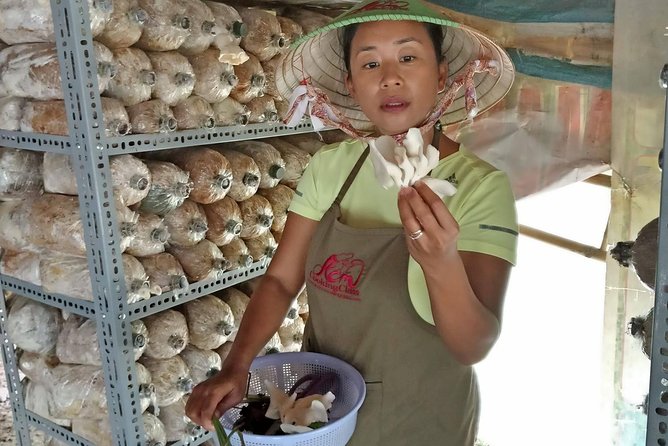Baekusaeng Makgeolli offers a unique hands-on experience called ‘Learn and Make Your Very Own Craft Makgeolli.’
Participants can enjoy the world of traditional Korean brewing and create their own personalized bottle of craft makgeolli.
Led by expert instructors, participants learn about the brewing techniques and history behind this traditional rice wine.
This activity not only provides valuable insights into Korean culture but also allows participants to take home their very own craft makgeolli.
Key Takeaways

- Makgeolli is a traditional Korean rice wine that has a long history and cultural significance.
- The main ingredients for making Makgeolli are rice, nuruk, and water, along with specific brewing equipment.
- The process of making Makgeolli involves cooking the rice, mixing it with nuruk and water, fermenting the mixture, and straining the liquid.
- Perfecting the craft of Makgeolli requires temperature control, choosing the right yeast strain, proper rice milling, and adjusting the fermentation process to achieve desired flavors.
The History of Makgeolli

The tour guide frequently discusses the history of Makgeolli during the craft brewing activity.
Makgeolli, also known as ‘Mak,’ is a traditional Korean rice wine with a history that dates back centuries. It has been enjoyed by Koreans for generations and holds a special place in their culture.
Makgeolli was first brewed during the Goryeo Dynasty and became a popular drink among the working class due to its affordability. Over time, it evolved and gained popularity among all classes, becoming a staple beverage in Korean households.
Today, Makgeolli is celebrated for its unique taste and cultural significance. By learning about its history, participants in the craft brewing activity gain a deeper appreciation for this traditional Korean drink and its importance in Korean society.
Ingredients and Equipment Needed for Making Makgeolli
Joe, the instructor, explains to the participants the essential ingredients and equipment required for making Makgeolli.
-
Rice: The main ingredient in Makgeolli is rice, specifically short-grain rice. It’s important to use high-quality rice for the best results.
-
Nuruk: Nuruk is a fermentation starter that’s essential for making Makgeolli. It’s made from a mixture of wheat, barley, and other grains. Nuruk contains enzymes that break down the starch in the rice, allowing for fermentation.
-
Water: Water is another crucial ingredient in making Makgeolli. It’s used for cooking the rice and diluting the final product to achieve the desired alcohol content.
-
Brewing Equipment: To make Makgeolli, you’ll need a large fermentation vessel, such as a ceramic jar or a food-grade plastic container. You’ll also need a cloth or lid to cover the vessel, as well as a strainer for separating the liquid from the solids.
Step-by-Step Guide to Making Makgeolli at Home

They can easily follow the step-by-step guide and make their own Makgeolli at home. Making this traditional Korean rice wine may seem daunting, but with the right ingredients and techniques, anyone can create a delicious batch of Makgeolli in their own kitchen.
First, gather the necessary ingredients: short-grain rice, nuruk (fermentation starter), and water. Rinse the rice thoroughly and cook it until it’s soft. Then, cool the rice and mix it with the nuruk and water in a sterilized container. Cover the container loosely and let it ferment for about a week, stirring daily.
During the fermentation process, the rice will break down and release natural sugars, which the nuruk will convert into alcohol. After a week, strain the liquid, discarding any solids. Transfer the liquid to a clean bottle and refrigerate for a few days to allow the flavors to develop.
Now, your homemade Makgeolli is ready to be enjoyed! Serve it chilled, and savor the unique taste and cultural experience of this traditional Korean beverage.
Cheers to your homemade Makgeolli!
Tips and Tricks for Perfecting Your Craft Makgeolli
.jpg)
To perfect their craft Makgeolli, enthusiasts should regularly taste and adjust the fermentation process for optimal flavor, typically every few days. This ensures that the drink reaches the desired level of sweetness, acidity, and carbonation.
Here are four tips and tricks for perfecting your craft Makgeolli:
-
Temperature control: Maintaining a consistent temperature during fermentation is crucial. Too high of a temperature can lead to off-flavors, while too low of a temperature can slow down fermentation. It’s important to find the ideal temperature range for your specific recipe and adjust accordingly.
-
Yeast selection: Different strains of yeast can greatly influence the flavor profile of Makgeolli. Experiment with different yeast strains to find the one that best suits your taste preferences.
-
Rice milling: The texture and quality of the rice used in Makgeolli production can impact the final product. Proper rice milling ensures that the enzymes necessary for fermentation are exposed, resulting in a better fermentation process and tastier Makgeolli.
-
Time and patience: Makgeolli fermentation is a slow process that requires patience. Allowing the drink to ferment for an appropriate amount of time will enhance its complexity and depth of flavor. Resist the temptation to rush the process and give the Makgeolli the time it needs to reach its full potential.
Exploring Different Flavors and Variations of Makgeolli
.jpg)
Craft Makgeolli enthusiasts are enthusiastically exploring the different flavors and variations of this traditional Korean drink. From fruity and sweet to tangy and earthy, there’s a wide range of flavors to discover.
Some variations of Makgeolli include adding different types of fruits or herbs during the fermentation process, resulting in unique and refreshing taste profiles. Others experiment with different types of rice or grains to create a more complex flavor profile.
The exploration of flavors and variations allows enthusiasts to appreciate the versatility of Makgeolli and expand their palate. This ongoing discussion among enthusiasts not only promotes creativity and innovation but also fosters a deeper understanding and appreciation for this beloved Korean drink.
Whether it’s attending tasting events or experimenting with homemade recipes, the journey of exploring Makgeolli’s flavors and variations is an exciting and delicious adventure.
Serving and Enjoying Your Homemade Craft Makgeolli

Joe loves serving and enjoying his homemade Craft Makgeolli with friends and family during festive gatherings. It’s a tradition that brings people together and creates lasting memories.
If you’re interested in joining the fun, here are four tips to help you serve and enjoy your homemade Craft Makgeolli like a pro:
-
Serve it chilled: Craft Makgeolli tastes best when served cold. Keep it in the refrigerator until you’re ready to enjoy it. This will enhance its refreshing and crisp flavors.
-
Use traditional vessels: To fully embrace the experience, serve your Craft Makgeolli in traditional Korean bowls or cups. This adds an authentic touch to your gatherings and enhances the overall enjoyment.
-
Pair it with Korean cuisine: Craft Makgeolli pairs well with a variety of Korean dishes. From spicy kimchi to savory bulgogi, the flavors of the food and the Makgeolli complement each other, creating a harmonious dining experience.
-
Share the experience: Craft Makgeolli is meant to be shared. Invite your friends and family to join you in the celebration. The joy of serving and enjoying homemade Craft Makgeolli is multiplied when shared with loved ones.
Frequently Asked Questions
What Is the Cost of the ‘Learn and Make Your Very Own Craft Makgeolli’ Activity?
The cost of the activity is not provided in the given information. Additional details about the activity, such as the cost, may be available on the Viator or Tripadvisor websites.
How Long Does the Activity Last?
The activity lasts approximately 2 hours. Participants can learn the process of making their own craft Makgeolli, a traditional Korean brew. It’s an engaging and informative experience that allows travelers to enjoy Korean culture.
Are There Any Age Restrictions for Participating in the Activity?
There are no age restrictions for participating in this activity. People of all ages can learn and make their own craft Makgeolli. It’s a fun and educational experience for everyone to enjoy.
Is Transportation Provided to and From the Meeting Point?
Yes, transportation is provided to and from the meeting point. Participants can enjoy the convenience of a hassle-free journey to the activity location, ensuring a smooth and enjoyable experience.
Can Participants Bring Their Own Ingredients and Equipment for Making Makgeolli?
Participants cannot bring their own ingredients and equipment for making makgeolli. All necessary ingredients and equipment will be provided during the activity. Participants can learn and make their very own craft makgeolli without the need to bring anything.
The Sum Up
To sum it up, the ‘Learn and Make Your Very Own Craft Makgeolli’ activity offered by Baekusaeng Makgeolli is a fantastic opportunity to delve into the world of traditional Korean brewing. Participants not only learn about the rich cultural heritage of Korea but also get to create their own personalized bottle of craft makgeolli. With expert instructors guiding them through the process and providing valuable insights, this hands-on experience is perfect for beer enthusiasts, lovers of Korean culture, and anyone curious about the art of brewing.
For those who enjoy immersive culinary experiences, there are also a variety of cooking classes available that allow you to explore different Asian cuisines. One such option is the Khmer Cooking Class in Krong Siem Reap, Cambodia. Led by a local chef, this half-day class introduces participants to the flavors and techniques of Khmer cuisine. From preparing traditional dishes to learning about local ingredients, this cooking class offers a unique opportunity to enjoy Cambodian culinary traditions.
If you’re interested in Japanese cooking, you might consider the Traditional Japanese Cooking Class at Mayuko’s home in Tokyo. This class provides a hands-on experience where you can learn to make authentic Japanese dishes from scratch. Mayuko, a passionate home cook, will guide you through the process of creating traditional dishes and share the cultural significance behind each recipe.
For those visiting Vietnam, the Hanoi Cooking Class and Market Tour with Chef Tien is a must-try experience. This class takes you on a culinary adventure through the vibrant streets of Hanoi, where you’ll explore local markets and learn about the ingredients used in Vietnamese cuisine. Under the guidance of Chef Tien, you’ll then have the opportunity to prepare and cook traditional Vietnamese dishes, gaining insight into the country’s rich culinary heritage.
Lastly, the Singaporean Cooking Class and Meal with Small Group offers a unique opportunity to learn about Singapore’s diverse food culture. Led by a local chef, this cooking class takes you on a journey through the flavors of Singapore, teaching you how to prepare iconic dishes such as Hainanese chicken rice and laksa. The small group setting allows for personalized instruction and a chance to interact with fellow food enthusiasts.
Don’t miss out on these incredible cooking class experiences that allow you to explore the culinary traditions of different Asian countries. Each class offers a unique opportunity to learn, cook, and savor the flavors of these rich and diverse cuisines.






